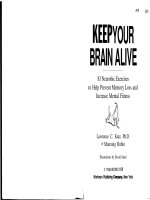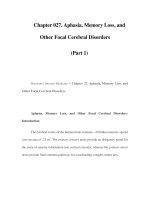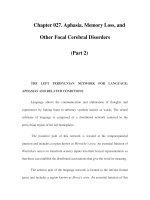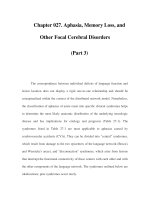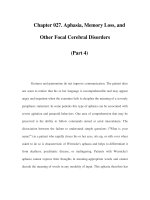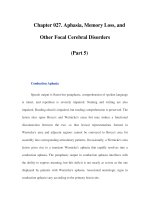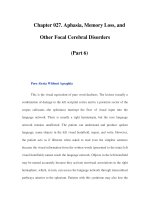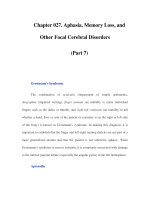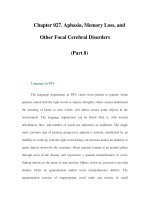Chapter 027. Aphasia, Memory Loss, and Other Focal Cerebral Disorders (Part 11) pps
Bạn đang xem bản rút gọn của tài liệu. Xem và tải ngay bản đầy đủ của tài liệu tại đây (14.63 KB, 5 trang )
Chapter 027. Aphasia, Memory Loss, and
Other Focal Cerebral Disorders
(Part 11)
The Occipitotemporal Network for Face and Object Recognition:
Prosopagnosia and Object Agnosia
Perceptual information about faces and objects is initially encoded in
primary (striate) visual cortex and adjacent (upstream) peristriate visual
association areas. This information is subsequently relayed first to the downstream
visual association areas of occipitotemporal cortex and then to other heteromodal
and paralimbic areas of the cerebral cortex. Bilateral lesions in the fusiform and
lingual gyri of the occipitotemporal cortex disrupt this process and interfere with
the ability of otherwise intact perceptual information to activate the distributed
multimodal associations that lead to the recognition of faces and objects. The
resultant face and object recognition deficits are known as prosopagnosia and
visual object agnosia.
The patient with prosopagnosia cannot recognize familiar faces, including,
sometimes, the reflection of his or her own face in the mirror. This is not a
perceptual deficit since prosopagnosic patients can easily tell if two faces are
identical or not. Furthermore, a prosopagnosic patient who cannot recognize a
familiar face by visual inspection alone can use auditory cues to reach appropriate
recognition if allowed to listen to the person's voice. The deficit in prosopagnosia
is therefore modality-specific and reflects the existence of a lesion that prevents
the activation of otherwise intact multimodal templates by relevant visual input.
Damasio has pointed out that the deficit in prosopagnosia is not limited to the
recognition of faces but that it can also extend to the recognition of individual
members of larger generic object groups. For example, prosopagnosic patients
characteristically have no difficulty with the generic identification of a face as a
face or of a car as a car, but they cannot recognize the identity of an individual
face or the make of an individual car. This reflects a visual recognition deficit for
proprietary features that characterize individual members of an object class. When
recognition problems become more generalized and extend to the generic
identification of common objects, the condition is known as visual object agnosia.
In contrast to prosopagnosic patients, those with object agnosia cannot recognize a
face as a face or a car as a car.
It is important to distinguish visual object agnosia from anomia. The patient
with anomia cannot name the object but can describe its use. In contrast, the
patient with visual agnosia is unable either to name a visually presented object or
to describe its use. The characteristic lesions in prosopagnosia and visual object
agnosia consist of bilateral infarctions in the territory of the posterior cerebral
arteries. Associated deficits can include visual field defects (especially superior
quadrantanopias) or a centrally based color blindness known as achromatopsia.
Rarely, the responsible lesion is unilateral. In such cases, prosopagnosia is
associated with lesions in the right hemisphere and object agnosia with lesions in
the left.
The Limbic Network for Memory: Amnesias
Limbic and paralimbic areas (such as the hippocampus, amygdala, and
entorhinal cortex), the anterior and medial nuclei of the thalamus, the medial and
basal parts of the striatum, and the hypothalamus collectively constitute a
distributed network known as the limbic system. The behavioral affiliations of this
network include the coordination of emotion, motivation, autonomic tone, and
endocrine function. An additional area of specialization for the limbic network,
and the one which is of most relevance to clinical practice, is that of declarative
(conscious) memory for recent episodes and experiences. A disturbance in this
function is known as an amnestic state. In the absence of deficits in motivation,
attention, language, or visuospatial function, the clinical diagnosis of a persistent
global amnestic state is always associated with bilateral damage to the limbic
network, usually within the hippocampo-entorhinal complex or the thalamus.
Although the limbic network is the site of damage for amnestic states, it is
almost certainly not the storage site for memories. Memories are stored in widely
distributed form throughout the cerebral cortex. The role attributed to the limbic
network is to bind these distributed fragments into coherent events and
experiences that can sustain conscious recall. Damage to the limbic network does
not necessarily destroy memories but interferes with their conscious (declarative)
recall in coherent form. The individual fragments of information remain preserved
despite the limbic lesions and can sustain what is known as implicit memory. For
example, patients with amnestic states can acquire new motor or perceptual skills,
even though they may have no conscious knowledge of the experiences that led to
the acquisition of these skills.
The memory disturbance in the amnestic state is multimodal and includes
retrograde and anterograde components. The retrograde amnesia involves an
inability to recall experiences that occurred before the onset of the amnestic state.
Relatively recent events are more vulnerable to retrograde amnesia than more
remote and more extensively consolidated events. A patient who comes to the
emergency room complaining that he cannot remember his identity but who can
remember the events of the previous day is almost certainly not suffering from a
neurologic cause of memory disturbance. The second and most important
component of the amnestic state is the anterograde amnesia, which indicates an
inability to store, retain, and recall new knowledge. Patients with amnestic states
cannot remember what they ate a few minutes ago or the details of an important
event they may have experienced a few hours ago. In the acute stages, there may
also be a tendency to fill in memory gaps with inaccurate, fabricated, and often
implausible information. This is known as confabulation. Patients with the
amnestic syndrome forget that they forget and tend to deny the existence of a
memory problem when questioned.
